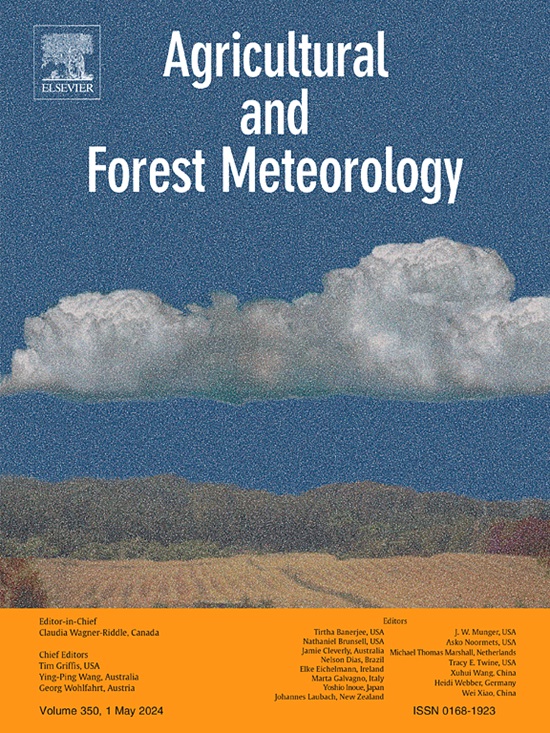Water availability regulates the carbon uptake period and amplitude of net ecosystem exchange in alpine grasslands of the Qinghai-Xizang Plateau
IF 5.6
1区 农林科学
Q1 AGRONOMY
引用次数: 0
Abstract
The Qinghai-Xizang Plateau (QZP) alpine ecosystem serves as a critical carbon (C) sink, with its seasonal and interannual variation in C assimilation capacity regulated by climatic factors. The C sequestration process in alpine grasslands on the QZP can be divided into the C uptake period (CUP) and the C emission period. However, the relative contributions of these periods to the interannual variability of net ecosystem exchange (NEE) remain unclear. In this study, we decomposed the annual NEE of QZP alpine ecosystems into phenological and physiological components, focusing on the CUP and the maximum rate of net C uptake (MCU). We analyzed interannual anomalies in seasonal and annual NEE, CUP, and MCU in relation to climatic variables across various alpine ecosystems, including alpine meadows (11 sites), alpine wetlands (seven sites), alpine shrub meadows (two sites), alpine steppes (three sites), and tame grasslands (one site). Our key findings indicate that alpine steppes exhibited the longest CUP but the lowest MCU, whereas tame grasslands had a shorter CUP than natural grasslands. Alpine wetlands demonstrated the highest MCU. Across the 84 site-years studied, we found that NEE was predominantly influenced by CUP, which accounted for 38 % of its variability, whereas MCU explained 18 %. The beginning date of the CUP (BDOY) in natural grasslands was primarily driven by spring precipitation. Summer water availability negatively affected MCU in natural grasslands but had a positive effect in tame grasslands. In contrast, human management practices (e.g., sowing and harvesting) determined the CUP of tame grasslands and, consequently, their interannual NEE variability. Winter ecosystem respiration (RE), which accounted for 15 % of annual RE, was largely controlled by snowfall and net radiation. The length of the CUP was determined by early-season precipitation and grassland type, contributing to interannual NEE variability and ecosystem differences.
水分有效性调节青藏高原高寒草原生态系统净交换的碳吸收期和幅度
青藏高原高寒生态系统是一个重要的碳汇,其碳同化能力的季节和年际变化受气候因子的调节。高寒草原在青藏高原的碳固存过程可分为碳吸收期和碳排放期。然而,这些时期对净生态系统交换(NEE)年际变率的相对贡献尚不清楚。在本研究中,我们将QZP高寒生态系统的年NEE分解为物候和生理组分,重点研究了CUP和最大净碳吸收率(MCU)。分析了高寒草甸(11个)、高寒湿地(7个)、高寒灌丛草甸(2个)、高寒草原(3个)和温带草原(1个)不同生态系统的季节和年度NEE、CUP和MCU的年际异常与气候变量的关系。结果表明:高寒草原的CUP最长,但MCU最低,而温顺草原的CUP短于天然草原;高寒湿地MCU最高。在研究的84个站点年中,我们发现NEE主要受到CUP的影响,CUP占其变异性的38% %,而MCU解释了18% %。自然草地CUP开始日期主要受春季降水驱动。夏季水分有效性对自然草原的微生态系统有负向影响,而对驯养草原有正向影响。相比之下,人类管理实践(如播种和收获)决定了驯服草原的CUP,从而决定了它们的年际NEE变异性。冬季生态系统呼吸(RE)占年RE的15. %,主要受降雪和净辐射的控制。早期降水和草地类型决定了生态系统的年际NEE变率和生态系统差异。
本文章由计算机程序翻译,如有差异,请以英文原文为准。
求助全文
约1分钟内获得全文
求助全文
来源期刊
CiteScore
10.30
自引率
9.70%
发文量
415
审稿时长
69 days
期刊介绍:
Agricultural and Forest Meteorology is an international journal for the publication of original articles and reviews on the inter-relationship between meteorology, agriculture, forestry, and natural ecosystems. Emphasis is on basic and applied scientific research relevant to practical problems in the field of plant and soil sciences, ecology and biogeochemistry as affected by weather as well as climate variability and change. Theoretical models should be tested against experimental data. Articles must appeal to an international audience. Special issues devoted to single topics are also published.
Typical topics include canopy micrometeorology (e.g. canopy radiation transfer, turbulence near the ground, evapotranspiration, energy balance, fluxes of trace gases), micrometeorological instrumentation (e.g., sensors for trace gases, flux measurement instruments, radiation measurement techniques), aerobiology (e.g. the dispersion of pollen, spores, insects and pesticides), biometeorology (e.g. the effect of weather and climate on plant distribution, crop yield, water-use efficiency, and plant phenology), forest-fire/weather interactions, and feedbacks from vegetation to weather and the climate system.

 求助内容:
求助内容: 应助结果提醒方式:
应助结果提醒方式:


